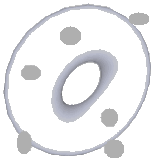Hematuria is defined as a high urine red blood cell count sustained over three specimens taken on different days. In a normal urine, less than 1,5 million erythrocytes are found in a 24-hour specimen. This normal value represents a count of less than 5 RBC/hpf. Hematuria is normally associated with a urinary tract disease. Some cases of idiopathic hematuria have been reported in the literature. Red blood cells originating from an external source, like vaginal bleeding, is not a true hematuria.
Two types of hematuria can be seen in urine
Lower urinary tract hematuria
|
||
Dysmorphic hematuria
Dysmorphocytosis is characterized by bizarre shapes and projections of the cell membrane called blebs. Schramek has demonstrated that the dysmorphocytosis can be reproduced in vitro, by osmotic shocks in a hemolytic media. This situation compares well with the travel of a red blood cell from the glomerule to the bladder. In glomerulonephritis, the dysmorphic cells can represent up to 80% of the erythrocytes. A value of 14% was proposed by Pillsworth, as a cut-off value for the differentiation of renal from non-renal hematuria. At room temperature, the specimen is stable for up to 5 hours . It is not rare to see, in a sediment, what seems to be two populations of erythrocytes. This situation could correspond to a mixed hematuria. Recently, a glomerular-specific morphological alteration of red cells has been described, G1 cells or doughnut-shaped erythrocytes (acanthocyte) with one or more blebs are considered to be reliable markers for glomerular diseases. Tomita et al Nagama et al have futher refined the dysmorphocytosis concept. . Dysmorphic G1 cells called D cells are subdivised under three groups called D1, D2, and D3.
The sensitivity of D3 cells and D1 and/or D2 cells (G1 cells) was 73% and 46%, respectively, for the detection of glomerular diseases and the specificity was 93% and 99%, respectively D3 cell is a sensitive marker for glomerular diseases, and that D1 and/or D2 cells are markers for severe glomerular diseases. |


